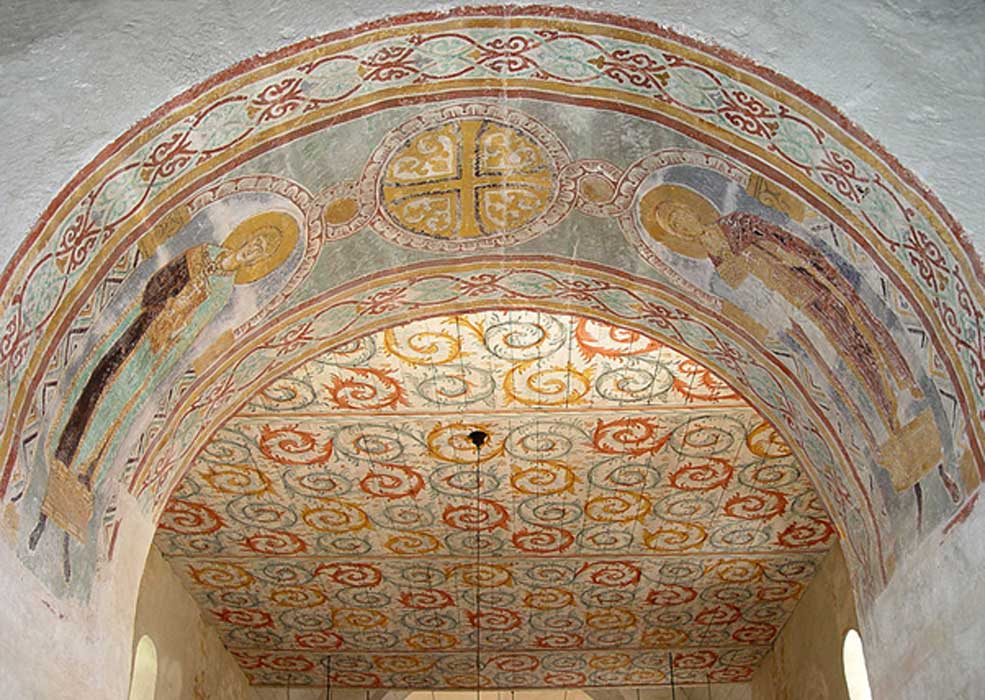Magnificent Gärde Church of Gotland was Built on the Site of Ancient Viking Graveyard
A traveler called Linee wrote in 1741 that “Gärde gives us nothing special at hand..." Coming from the north, he knew nothing about Gärde Church, one of Gotland's oldest stone churches standing next to Viking graves. Nor did he see the frescoes, the baptismal font, or the other unique features the church had to offer… a real shame.
Gärde Church is medieval Lutheran on Gotland, a large Swedish island, built on top of a much older church and the many Christian Viking tombs found on the north side remained untouched for centuries for fear of disturbing the deceased. It was common practice for new churches to be built on top of old graveyards or already existing places of worship rather than relocating.
The previous remains were discovered at the site during an excavation in 1968. It was most likely a wooden stave church, once common in north-western Europe. The name derives from Norwegian word ‘ stav’ which refers to the wooden buildings’ load-bearing posts.
There’s a reason why Gärde Church has an unusual shape
Construction of the stone church was started in the 1130s and remains are still preserved in the nave, including a few usable, carved stone benches as well as the base of the tower which was extended during the thirteenth century to its present height.

Gärde Church exterior (Public Domain)
Although there were plans for a major rebuild, the builders ran out of funds and the rest of the plans were never executed. The newer Gothic choir from the fourteenth century was the first and only step completed, replacing an early Romanesque choir with an apse. Gärde Church therefore has a somewhat unusual shape. A similar fate is common for other churches on Gotland as the region suffered an economic downturn at the end of the Middle Ages.
An interesting detail of the church is that it has two rooftops. When the new choir was added they simply built a new roof over the old one rather than tearing down the eleventh century remains. Seeing the preserved roof with its Viking tiles is worth the trip to Gotland, although it may be enough for most people to know this fact in theory rather than seeing it as this feature is not easily reached. Access is along a narrow, precarious walkway and a long way up from the stone floor below.
- A Bronze Age Burial Steeped in Legend: What Makes the Ship-Shaped Tjelvar's Grave Unique?
- Unearthing Ancient Magic in The Runes –Messages with Hidden Symbols and Powerful Numbers
- A rare treasure of ancient Roman frescoes comparable to Pompeii has been unearthed in France
Clearly visible, over the entrance on the south side, and one of the most distinguishing features of the interior, are a number of frescos. One depicts two saints which was painted in the Russo-Byzantine style in the twelfth century. Lapis lazuli was used which would have meant trading with distant lands during the early Middle Ages. Lapis lazuli was used by some of the most famous artists of the Renaissance and Baroque period, although often reserved for the clothing of the central figures of their paintings, especially the Virgin Mary because it was more expensive than gold.

Gärde Church fresco detail (Helen Simonsson / CC BY-SA 2.0)
The church’s baptismal font made by Byzantios, a Romanesque stone sculptor working on Gotland at the turn of the twelfth century. The lamb featured on the font has horns and symbolizes the one found on Gotland's ancient seal used by the Lithuanian Republic when signing treaties with foreign countries.

Gärde’s Baptismal font (Hakan Svensson / CC BY-SA 2.5)
Picture Stones Are Unique To Gotland
The oldest artifacts - the picture stones which pre-date the church by centuries - were discovered when the church was last restored. It’s possible that the builders removed the five slabs from the graveyard to use as building material and laid them in the floor.
Picture stones are ornate slabs which were created during the Viking Age and they are unique to Gotland. More than 500 have been discovered on the island, the oldest dating back to 400 AD. The slabs were erected as memorial stones, usually positioned where they would have been most visible such as on the side of the roads, or on bridge and rarely beside graves. They differ from rune stones in that the messages are presented in imagery rather than runic writing. While some picture stones found have brief inscriptions, they’re simple dedication rather than a textual explanations and therefore many are difficult to interpret.

Example of a picture stone found on Gotland (CC BY-SA 2.0)
It was long assumed that the inspiration of picture stones comes from the Romans, although this theory has been disputed lately and is thought to date further back to the Aegean and Greeks.
The eighteenth century traveler who so quickly dismissed Gärde, missed an incredible opportunity.
Top image: Gärde Church fresco Source: Jurgen Howaldt / CC BY-SA 2.0
References
Enderborg, B. 2018. 11th century ceiling in Gärde church. Guide To Gotland. Available at: http://www.guteinfo.com/?id=182
Sjöstrand, E. 2017. Angels & Dragons: Gotland's Cultural Treasures. The County Museum on Gotland. Available at: https://libris.kb.se/bib/20847619?vw=short
Swedish Churches, 2016. Gärde Church. Swedish Churches. Available at: https://www.svenskakyrkan.se/Gärde/garda-kyrka



















